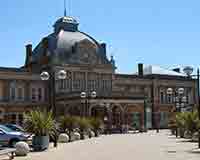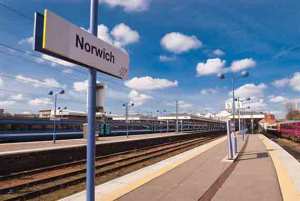 Norwich, city of Colman’s Mustard, Aviva Insurance and Alan Partridge, is only 100 miles from London, but poor rail and road links have made it seem much further away, with the two-hour train journey hardly an inducement to investors.
Norwich, city of Colman’s Mustard, Aviva Insurance and Alan Partridge, is only 100 miles from London, but poor rail and road links have made it seem much further away, with the two-hour train journey hardly an inducement to investors.
The A11 road was finally improved in December when the Highways Agency completed its £105m dualling near Thetford and a bypass of the notorious Elveden bottleneck.
Now it is the railway’s turn. Network Rail is due to make a series of technical improvements that will cut the journey from London to 90 minutes, a move that followed a lengthy campaign known as Norwich in Ninety, led by local politicians and business groups.
With reduced travelling times and easier journeys to and from London, what benefits could these initiatives bring to Norwich’s property market?
Will Jones, head of Bidwells’ commercial team in Norwich, says: “Speeding up the train journey is helpful because, at nearly two hours each way, Norwich feels a long way from London, but at 90 minutes it is much more accessible.
“Together with the dualling of the A11, which has reduced the road journey to Cambridge from 90 minutes to one hour, it will have a positive effect.”
However, Jones doubts there will be wholesale relocations from London because the occupation market tends to be driven by local companies that often have offices in the east and south of England.
“I would expect to see expansion come from them, and from the ability the better links give to retain them in the city, rather than from relocations,” he says.
“Norwich is still the end of the line and people do not pass through it like they might with Chelmsford or Colchester.”
Interestingly, Sam Kingston, partner at local agent Roche, feels the transport improvements may attract people from Suffolk or Cambridgeshire because of the shorter journey times and also the lower cost of property in Norwich.
“I think Norwich in Ninety will strengthen major businesses that are already here as executives from Aviva, for example, can get to their clients in London more easily,” says Kingston.
He feels higher commercial rents will be seen mostly in the city centre, but could stretch the three miles to Broadland Business Park, Norwich’s main out-of-centre location.
“Norwich’s centre is small and most places are a five-minute cab ride or walking distance from the station, so I could see benefits accruing to the whole city centre,” he says.
Kingston thinks the improved road link could lead to some residential and industrial development at intermediate towns, such as Attleborough or Wymondham, although he feels neither has the critical mass of offices needed to attract investment in that sector.
“Industrial premises there could attract people who serve the Cambridgeshire area, as Cambridge is really overheating,” he says.
Craig Knights, a partner at local property firm Arnolds Keys, agrees that the road and rail improvements open up the possibility of Norwich becoming a realistic alternative to Cambridge, “especially given that city’s overheated commercial and residential property market”.
“Norwich suffers a distinct lack of grade-A office space, with not much in the pipeline, so there is a big opportunity for investors here,” says Knights.
“Any new grade-A space could benefit from pent-up demand, and if the promised infrastructure improvements happen, I predict that grade-A space will be costing £20 per sq ft within the next five years.”
Perceptions of the city are also key. David Merrick, head of office development at Savills’ Norwich office, says the improved connections “will also make a difference in how people feel about Norwich – that it’s not so far away from other cities”.
Merrick thinks the main benefit will be felt by offices near the station, and also believes relocations could be on the cards: “I keep telling people that Norwich offers a great combination of culture, leisure and retail and is attracting start-up businesses, often by graduates who have stayed on.
 Direct rail link with Liverpool could be scrapped
Direct rail link with Liverpool could be scrapped
Although the Norwich in Ninety campaign is being deemed a success, there is less good news on other local rail initiatives.
The East Anglia rail franchise consultation is a proposal to improve rail links between the rapidly growing economy around Cambridge and northern England.
The consultation, which started last December and ran until the middle of March, proposed ending Norwich’s direct 5.5-hour rail link to Liverpool via Peterborough, Nottingham, Sheffield and Manchester, in favour of improving connectivity between Cambridge and the North, leaving Norwich with only a connecting service.
Sam Kingston, partner at Roche, feels the loss of the direct rail link with Liverpool would be a “potential problem, as when people are deciding on locations, they look at a whole matrix of issues, including links around the country”.
The next franchise will start in October 2016, when the present Greater Anglia franchise expires.
Office supply hits six-year low
According to local agent Bidwells, availability of office space in Norwich has fallen below 10% for the first time in six years because supply has gradually been soaked up over the years and no new developments have taken place.
Bidwells calculates this leaves grade-A supply at just 50,000 sq ft. This could present a development opportunity if higher rents could be achieved.
Norwich’s grade-A office space fetches rents of £16.50 per sq ft, better than rival Ipswich’s £14.50 but below the £18 per sq ft in Bury St Edmunds, says Bidwells. Industrial rents stand at £5.75 per sq ft.










